lepke
"Shadowland" is a revelatory and dramatic true-life thriller spanning much of the twentieth century, a page-turning chronicle of an elaborate Mafia plan to 'invade' Europe using 1960s London as a bridgehead. The capital city of the Swinging Sixties was also a world of gambling, guns and gangsters. Several veterans of the era are astonished that they survived it and some feel protected enough - now that most of the killers are themselves dead - to reveal to bestselling author Douglas Thompson the details and secrets of one of history's greatest criminal conspiracies, and of how world-champion boxer Freddie Mills really died. The tension in this real-life narrative is ferocious as the tale moves from London to New York and Las Vegas,
was also a world of gambling, guns and gangsters. Several veterans of the era are astonished that they survived it and some feel protected enough - now that most of the killers are themselves dead - to reveal to bestselling author Douglas Thompson the details and secrets of one of history's greatest criminal conspiracies, and of how world-champion boxer Freddie Mills really died. The tension in this real-life narrative is ferocious as the tale moves from London to New York and Las Vegas, 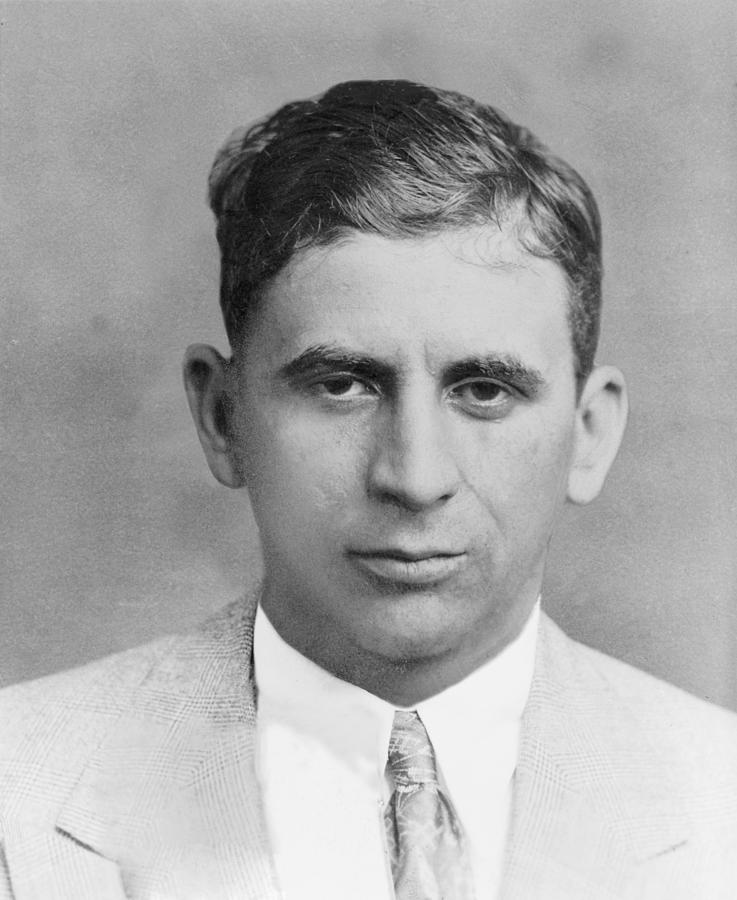 down to Miami, into Havana, then on to the Bahamas and back to an unexpected denouement in London. Brutal, terrifying and intrigue-packed
down to Miami, into Havana, then on to the Bahamas and back to an unexpected denouement in London. Brutal, terrifying and intrigue-packed , it is an account of the Mob's Machiavellian global manipulation of governments and officials. "Shadowland" recounts events from the viewpoint of the pawns as well as the kingmakers.
, it is an account of the Mob's Machiavellian global manipulation of governments and officials. "Shadowland" recounts events from the viewpoint of the pawns as well as the kingmakers. 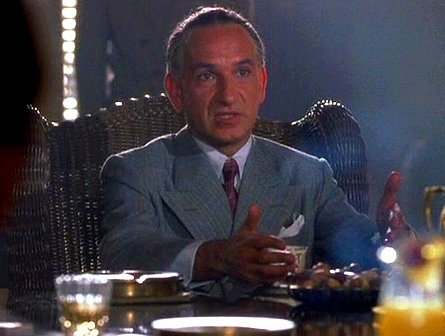 All the big players of Mafia history are here, controlled by the gangster genius Meyer Lansky, but so are the hit men, the fixers, the hoodlums and the wiseguys.
All the big players of Mafia history are here, controlled by the gangster genius Meyer Lansky, but so are the hit men, the fixers, the hoodlums and the wiseguys.
This vigorous determination to keep gambling clean had earlier resulted in the fairly successful elimination of Mafia interests. In the mid-1960s, American organized crime had seen London as a very promising venue for gambling junkets and skim operations. Meyer Lansky and associates like the Cellini brothers had tried to move in with the Colony Club of 1966, and Mafiosi like Bruno and Tony Corallo had also visited. In 1968, a representative of London's Victoria Sporting Club was arrested with Angelo Bruno in Philadelphia, while discussing junkets and the collection of bad debts. Bruno had fenced stolen securities in London and was allegedly connected to figures like the Krays and Albert Dimes. Here is the corner of Old Compton and Frith Street in 1976. The Continental Fruit Stores, scene of the infamous fight between local tough guys Albert Dimes and Jack Spot
Here is the corner of Old Compton and Frith Street in 1976. The Continental Fruit Stores, scene of the infamous fight between local tough guys Albert Dimes and Jack Spot  in the 1950s
in the 1950s
At this point the British government stepped in with a series of expulsions. The most that can be said of the American 'Mafia' or syndicate involvement in London gambling after 1969 is that some groups may have maintained a surreptitious interest and kept a small skim operation operating somewhere. But… the Gaming Board and the local Licensing Justices were normally prepared to crush vigorously the slightest sign of malfeasance.
George Ranft, began life in the Hell’s Kitchen section of New York City, a neighborhood that necessitated the development of the “tough guy” image which would serve him so well in later years. He tried prizefighting for a time, but eventually gave it up in favor of much less violent pursuits. Showing a great interest
He tried prizefighting for a time, but eventually gave it up in favor of much less violent pursuits. Showing a great interest  and aptitude for dance, the dashing young man found himself working in some of New York City’s most fashionable nightclubs.
and aptitude for dance, the dashing young man found himself working in some of New York City’s most fashionable nightclubs. 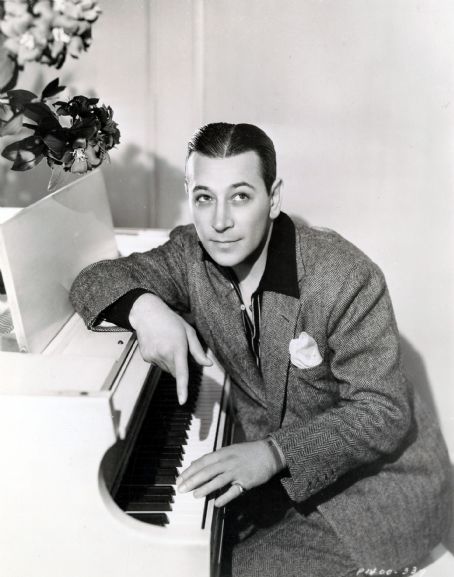 He earned a spot in the stage act of Texas Guinan and eventually landed on Broadway.
He earned a spot in the stage act of Texas Guinan and eventually landed on Broadway. 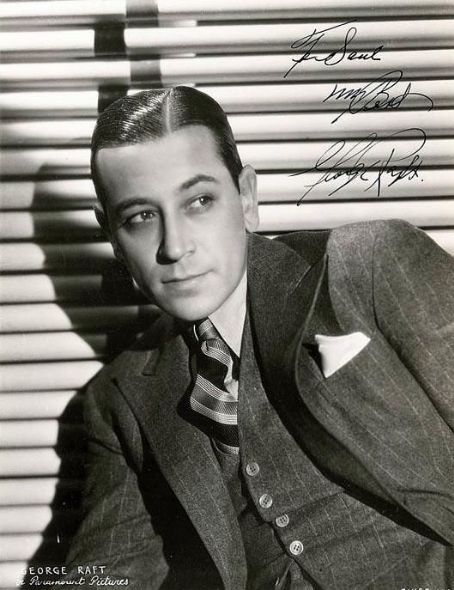
While working in the nightclubs, George was introduced to the world of organized crime, an association that would last throughout his life, but he was soon hearing the siren call of Hollywood and he left New York behind for the movie business. He arrived in Hollywood in 1928 and took a succession of small roles until his
and he left New York behind for the movie business. He arrived in Hollywood in 1928 and took a succession of small roles until his breakout performance in 1932’s “Scarface”. Playing Guino Rinaldo, the cool-headed henchman to Paul
breakout performance in 1932’s “Scarface”. Playing Guino Rinaldo, the cool-headed henchman to Paul Muni’s Tony Camonte, Raft stood out with his toned down, well crafted performance.
Muni’s Tony Camonte, Raft stood out with his toned down, well crafted performance.
By 1967, Raft's underworld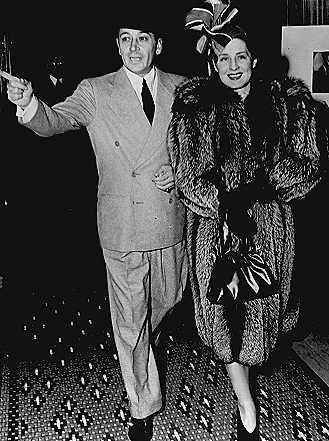 connections caught up with him again and he was banned from England. He had been there in association with the
connections caught up with him again and he was banned from England. He had been there in association with the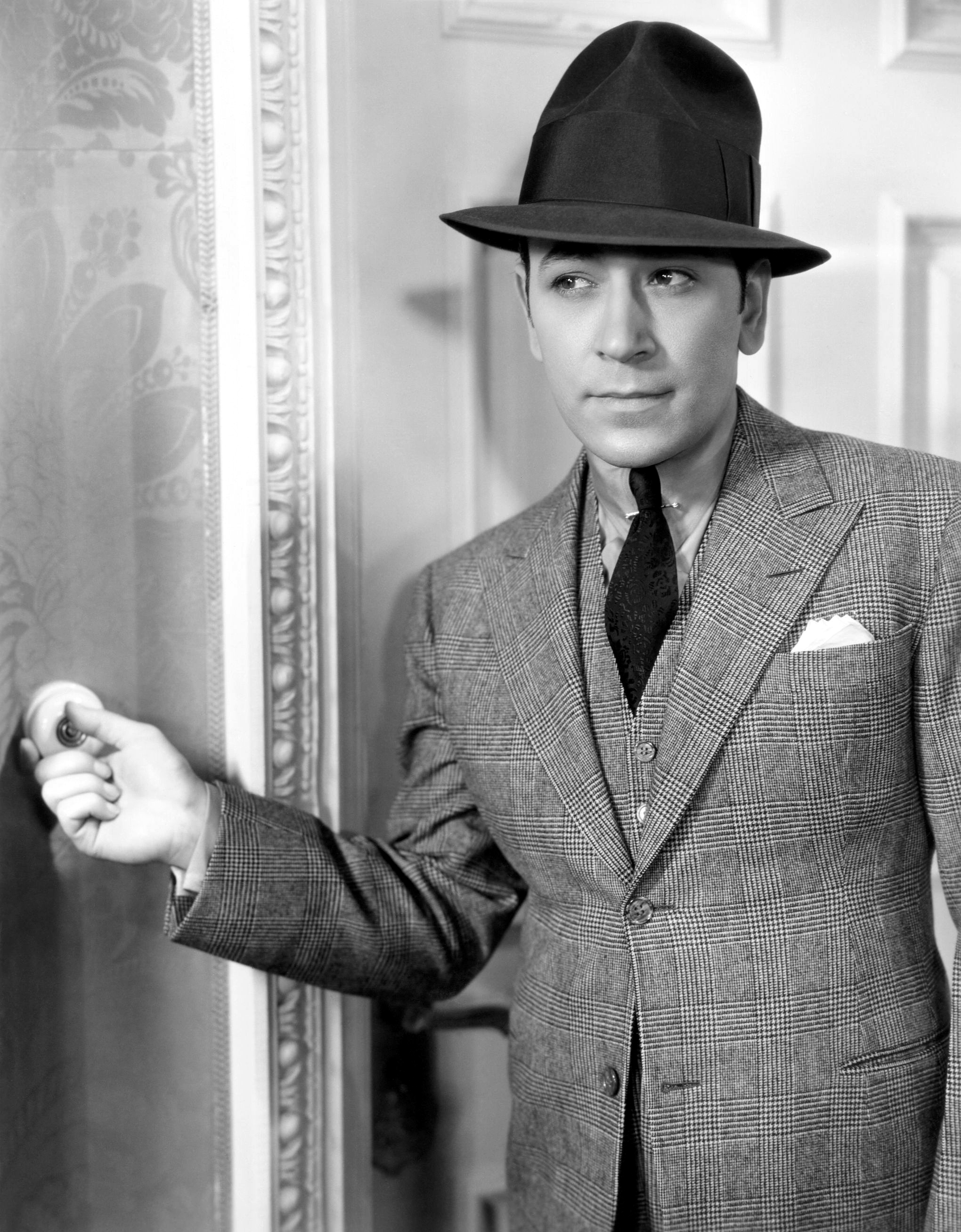 George Raft's Colony Sports Club (a gambling establishment) in London as the club's host, although it was supposedly owned by mobster Meyer Lansky. When Raft
George Raft's Colony Sports Club (a gambling establishment) in London as the club's host, although it was supposedly owned by mobster Meyer Lansky. When Raft 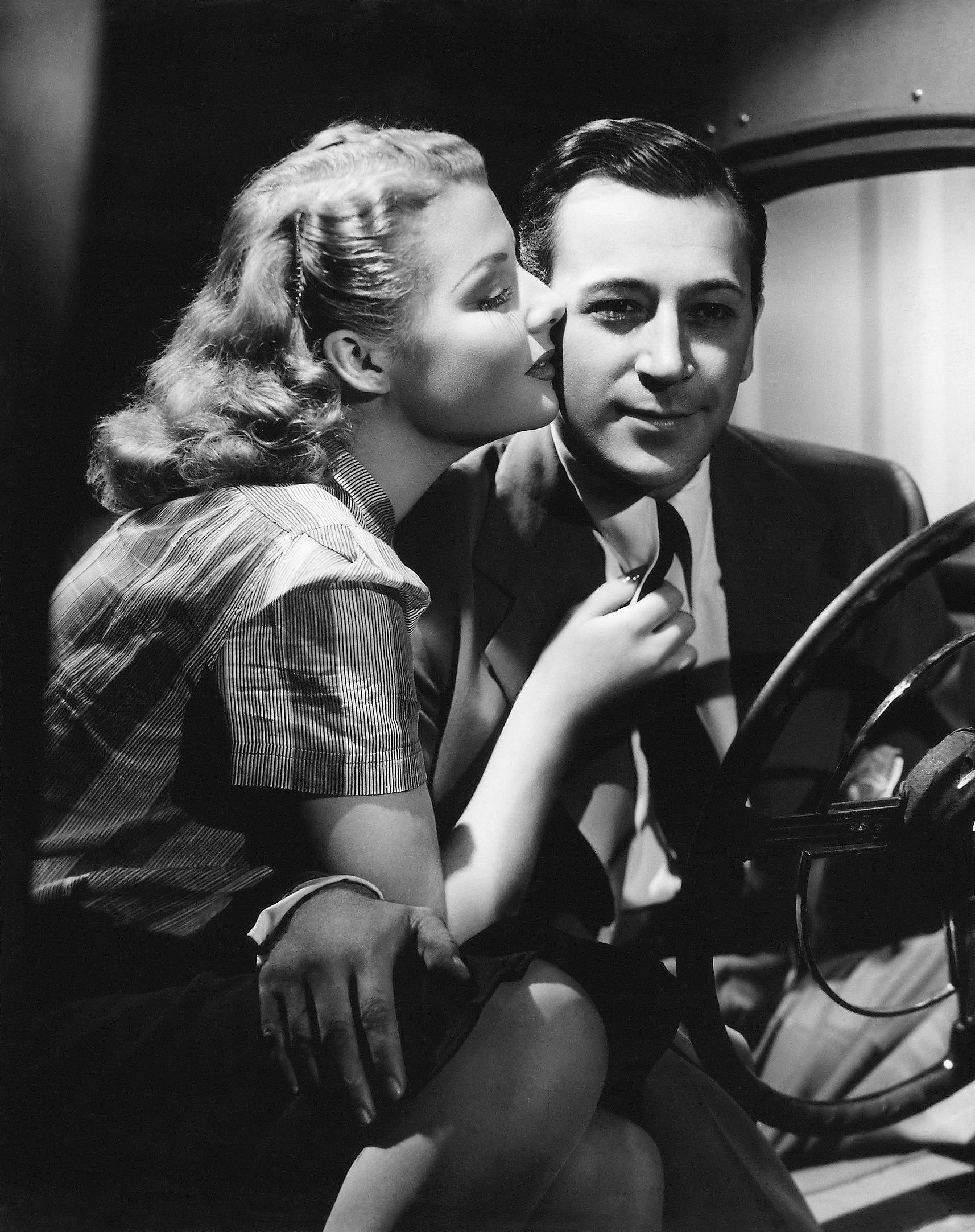 left for a brief trip back to California, he was informed that he would not be allowed back into the country.
left for a brief trip back to California, he was informed that he would not be allowed back into the country.  He did not fight the ban, but called it a "surprising body blow." It was not the first time Raft
He did not fight the ban, but called it a "surprising body blow." It was not the first time Raft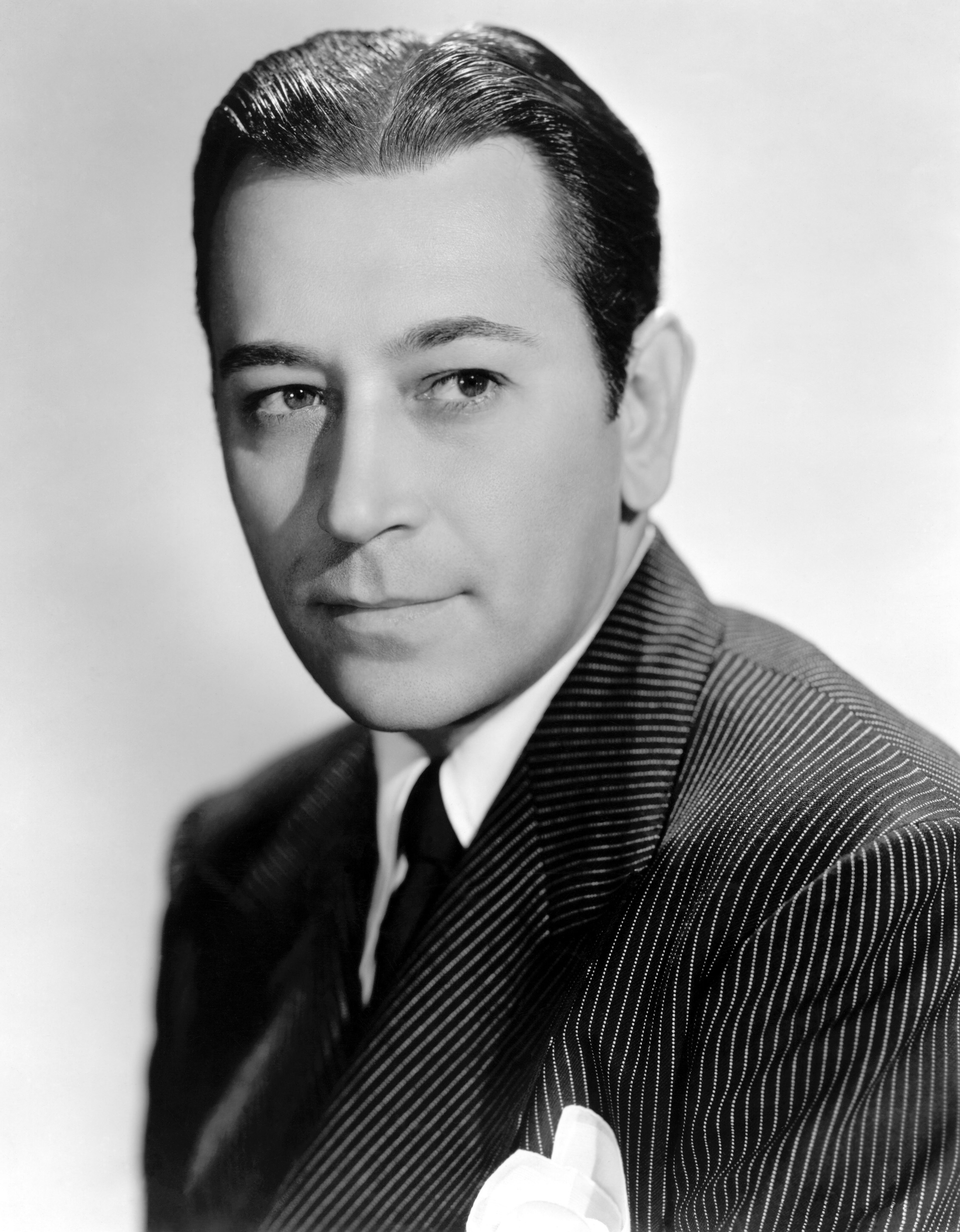 had been in trouble for gambling; in 1944 he had been investigated by the LA district attorney over a dice game with an airplane parts manufacturer in which he supposedly won $10,000. Raft
had been in trouble for gambling; in 1944 he had been investigated by the LA district attorney over a dice game with an airplane parts manufacturer in which he supposedly won $10,000. Raft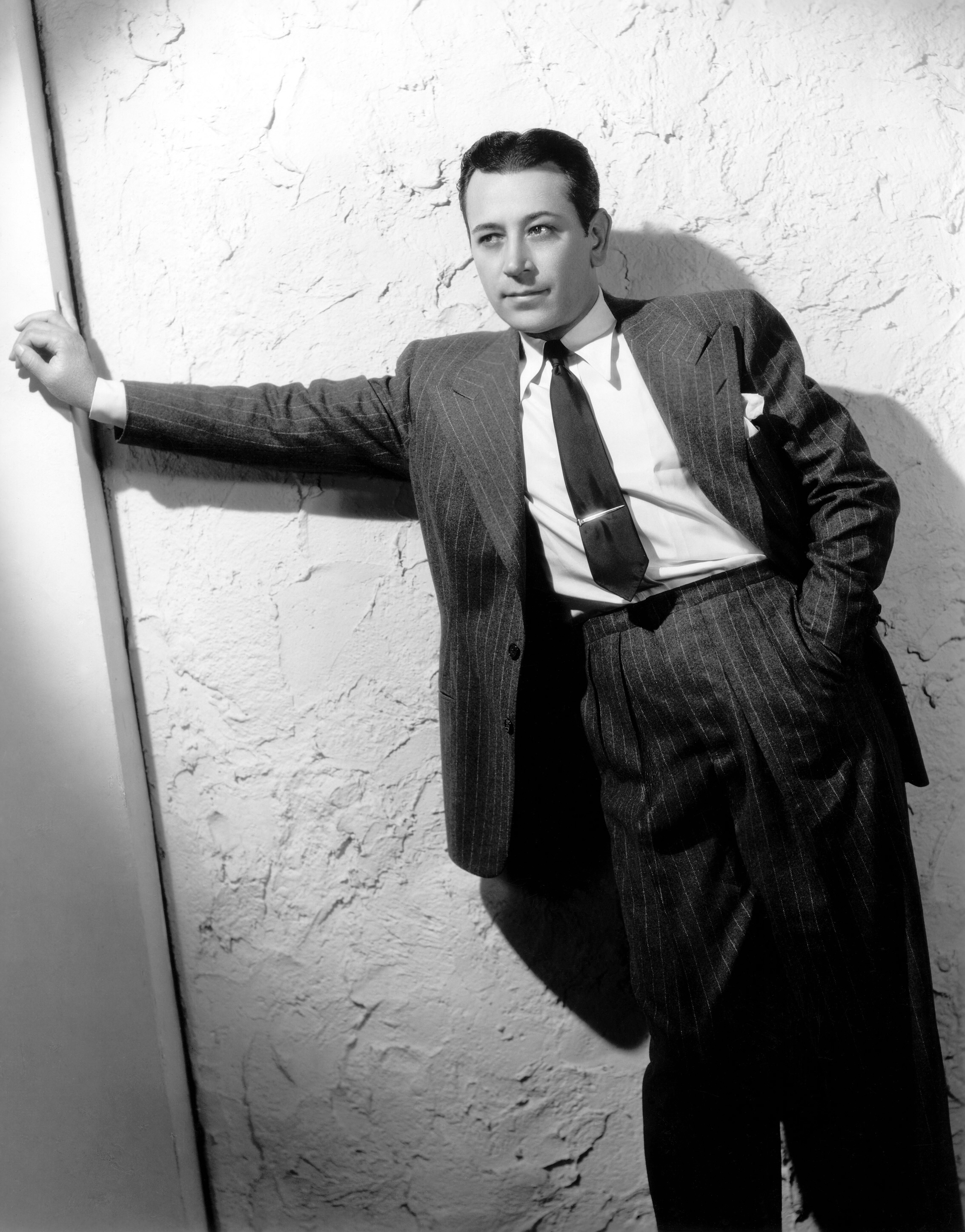 always maintained that the underworld connections were just acquaintances. "I've never been locked up, I've never taken a drink, I never hurt anybody,
always maintained that the underworld connections were just acquaintances. "I've never been locked up, I've never taken a drink, I never hurt anybody,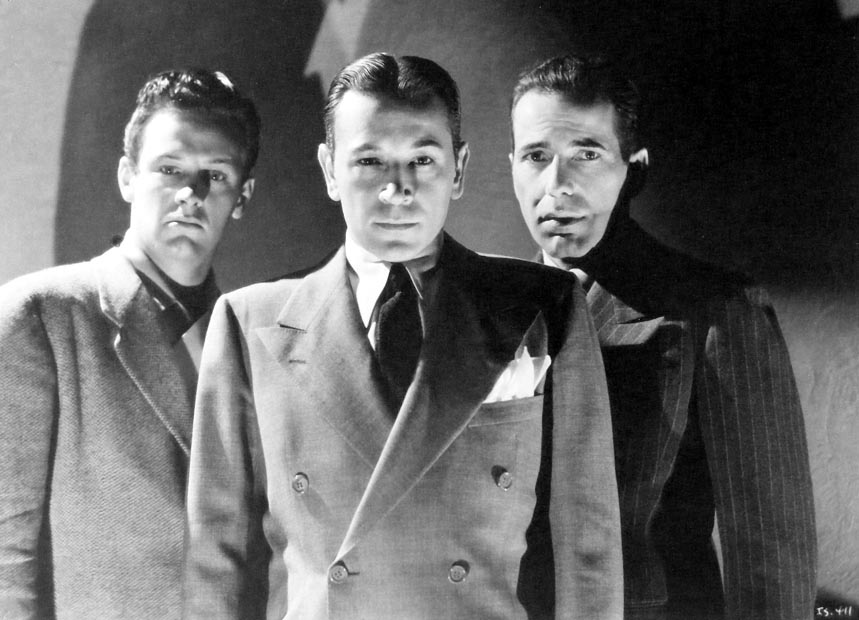 and I gave all my money away. So how come I got this bum reputation?"
and I gave all my money away. So how come I got this bum reputation?"
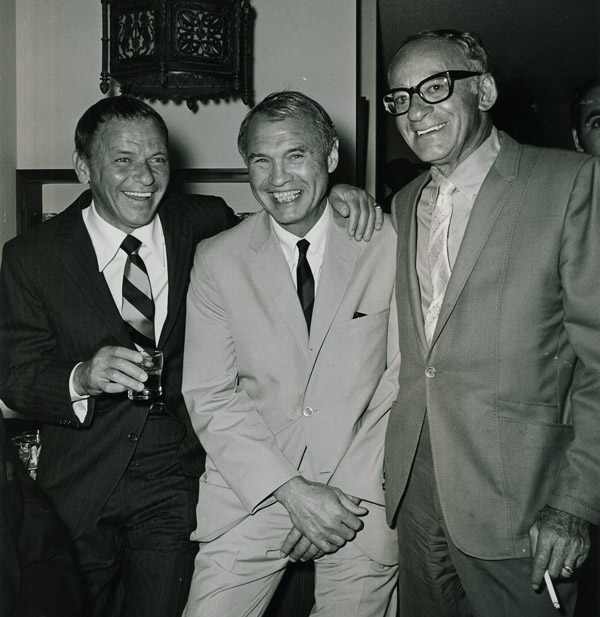 figure who, along with his associate Charles "Lucky" Luciano, was instrumental in the development of the
figure who, along with his associate Charles "Lucky" Luciano, was instrumental in the development of the "National Crime Syndicate" in the United States. For decades he was thought to be one of the most powerful people in the country.
"National Crime Syndicate" in the United States. For decades he was thought to be one of the most powerful people in the country.
Lansky developed a gambling empire which stretched from Saratoga, New York to Miami to Council Bluffs, Iowa and Las Vegas; it is also said that he oversaw gambling concessions in Cuba. Although a member of the Jewish Mob, Lansky undoubtedly had strong influence with the Italian Mafia and played a large role in the consolidation of the criminal underworld (although the full extent of this role has been the subject of some debate).
and Las Vegas; it is also said that he oversaw gambling concessions in Cuba. Although a member of the Jewish Mob, Lansky undoubtedly had strong influence with the Italian Mafia and played a large role in the consolidation of the criminal underworld (although the full extent of this role has been the subject of some debate).
Lansky was born Meyer Suchowljansky in Grodno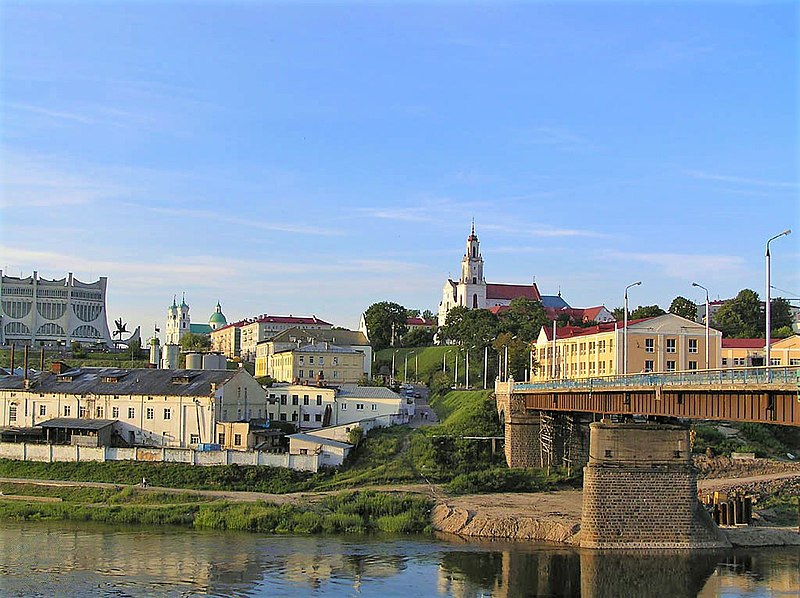 (then in Russia, now in Belarus), to a Jewish family who, he claimed, experienced pogroms.In 1911, he emigrated to the United States through the port of Odessa
(then in Russia, now in Belarus), to a Jewish family who, he claimed, experienced pogroms.In 1911, he emigrated to the United States through the port of Odessa  with his mother and brother and joined his father, who had previously emigrated to the United States in 1909, and settled on the Lower East Side of Manhattan, New York.
with his mother and brother and joined his father, who had previously emigrated to the United States in 1909, and settled on the Lower East Side of Manhattan, New York.
Lansky met Bugsy Siegel
 when they were teenagers. They became lifelong friends, as well as partners in the bootlegging trade, and together with Lucky Luciano, formed a lasting partnership.
when they were teenagers. They became lifelong friends, as well as partners in the bootlegging trade, and together with Lucky Luciano, formed a lasting partnership. Lansky was instrumental in Luciano's rise to power by organizing the 1931 murder of Mafia powerhouse Salvatore Maranzano. As a youngster, Siegel saved Lansky's life several times, a fact which Lansky always appreciated. The two adroitly managed the Bugs and Meyer Mob despite its reputation as one of the most violent Prohibition gangs.
Lansky was instrumental in Luciano's rise to power by organizing the 1931 murder of Mafia powerhouse Salvatore Maranzano. As a youngster, Siegel saved Lansky's life several times, a fact which Lansky always appreciated. The two adroitly managed the Bugs and Meyer Mob despite its reputation as one of the most violent Prohibition gangs.
Allen Smiley, a former Hollywood producer turned gangster, and his daughter, Lily. Smiley was “Bugsy” Siegel’s best friend and business partner, and was seated next to Benny the night he was murdered. He became an upper-echelon representative of Meyer Lansky’s criminal empire.Lansky was the brother of Jacob "Jake" Lansky, who in 1959 was the manager of the Nacional Hotel in Havana, Cuba. First of all, and last of all, Allen Smiley was Bugsy Siegel’s friend. In a sense, he was Bugsy’s shadow. When you saw one, you usually saw the other The hitman that shot Bugsy Siegel saw them together too…
First of all, and last of all, Allen Smiley was Bugsy Siegel’s friend. In a sense, he was Bugsy’s shadow. When you saw one, you usually saw the other The hitman that shot Bugsy Siegel saw them together too… 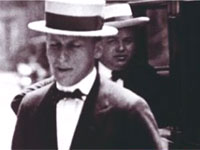 arnold rothstein
arnold rothstein
Arnold Rothstein (January 17, 1882 – November 5, 1928), nicknamed "the Brain," was a Jewish New York racketeer, businessman and gambler who became a kingpin of the Jewish mob in New York. Rothstein was widely reputed to have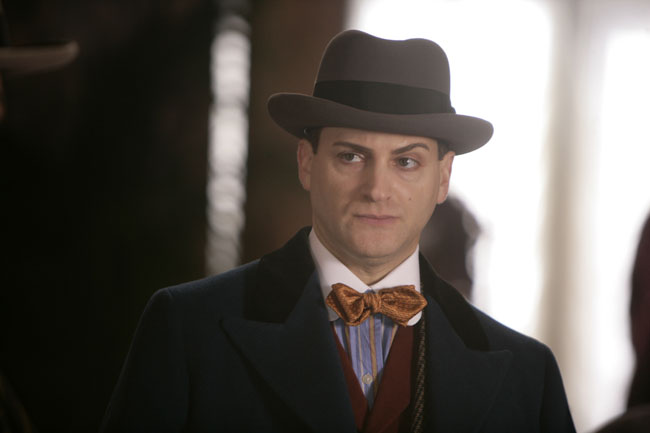 organized corruption in professional athletics, most notoriously conspiring in the fixing of the 1919 World Series Black Sox Scandal.
organized corruption in professional athletics, most notoriously conspiring in the fixing of the 1919 World Series Black Sox Scandal.
According to the crime writer Leo Katcher, Rothstein "transformed organized crime from a thuggish activity by hoodlums into a big business, run like a corporation, with himself at the top." According to Rich Cohen, Rothstein was the person who first realized that Prohibition was a business opportunity, a means to enormous wealth, who "understood the truths of early century capitalism and came to dominate them."His notoriety inspired several fictional characters based on his life, portrayed in contemporary and later short stories, novels, musicals and films.
By the time Titanic Thompson (above) was called as a witness in the 1929 murder trial of Rothsteinhe was the most infamous and itinerant hustler in American history. He’d won millions playing poker and shooting craps, had slain four men, wed three women and earned his Sergeant’s stripes in the army. He’d gambled with gangsters, danced with dames and had conned, wrangled, lied and fled in every state in America. What’s more, he’d done it without booze or fags, having promised his Mother he would never smoke or drink.
when Assistant District Attorney Ferdinand Pecora asked him to explain to the courtroom what he did for a living, the answer, “I play a little golf for money,” is perhaps one of the biggest understatements of the 20th century. It is not, however, a direct lie. Somehow, in between all of his countless shenanigans, Thompson did play golf for money. Shedloads of it.

By 1936, Lansky had established gambling operations in Florida, New Orleans, and Cuba. These gambling operations were successful as they were founded upon two innovations:
In 1936, Lansky's partner Luciano was sent to prison.
Lansky later convinced the Mafia to place Bugsy Siegel in charge of Las Vegas, and became a major investor in Siegel's Flamingo Hotel.
During the 1940s, Lansky's associate Siegel persuaded the crime bosses to invest in a lavish new casino hotel project in Las Vegas, the Flamingo. After long delays and large cost overruns, the Flamingo Hotel was still not open for business. To discuss the Flamingo problem, the Mafia investors attended a secret meeting in Havana, Cuba in 1946. While the other bosses wanted to kill Siegel, Lansky begged them to give his friend a second chance. Despite this reprieve, Siegel continued to lose Mafia money on the Flamingo Hotel. A second family meeting was then called. However, by the time this meeting took place, the casino turned a small profit. Lansky again, with Luciano's support, convinced the family to give Siegel some more time.
While the other bosses wanted to kill Siegel, Lansky begged them to give his friend a second chance. Despite this reprieve, Siegel continued to lose Mafia money on the Flamingo Hotel. A second family meeting was then called. However, by the time this meeting took place, the casino turned a small profit. Lansky again, with Luciano's support, convinced the family to give Siegel some more time.
The Flamingo was soon losing money again. At a third meeting, the family decided that Siegel was finished. It is widely believed that Lansky himself was compelled to give the final okay on eliminating Siegel due to his long relationship with Siegel and his stature in the family.
On June 20, 1947, Siegel was shot and killed in Beverly Hills, California. Twenty minutes after the Siegel hit, Lansky's associates, including Gus Greenbaum
After Siegel's murder in June 1947, Greenbaum brought the struggling casino out of debt within several months, controlling several other syndicate casinos and bookmaking operations in Arizona within several years. Greenbaum planned to retire to Arizona and rejected offers to run the Riviera for Tony Accardo, though after Greenbaum's sister-in-law was murdered, he accepted the job. As a syndicate leader in Las Vegas, Greenbaum would order the deaths of Tony Brancato and Tony Trombino for robbing a syndicate hotel. Shortly after his close friend and Chicago-enemy Willie Bioff's murder, Greenbaum's now worsening gambling, womanizing, and drug habits eventually caused him to begin skimming from casino operations. His embezzlement was discovered by the Chicago syndicate. On December 3, 1958, Greenbaum and his wife Bess were found dead in their (below) Phoenix home. Their throats had been cut with a butcher knife. Gus was found in bed with a heating pad and his television turned on. He had nearly been decapitated. Bess sustained blunt trauma to her head before her throat was cut. Her head was padded with newspaper and a towel, seemingly to avoid blood stains on the furniture. and Moe Sedway, walked into the Flamingo Hotel and took control of the property. According to the Federal Bureau of Investigation, Lansky retained a substantial financial interest in the Flamingo for the next twenty years. Lansky said in several interviews later in his life that if it had been up to him, "... Ben Siegel would be alive today."
and Moe Sedway, walked into the Flamingo Hotel and took control of the property. According to the Federal Bureau of Investigation, Lansky retained a substantial financial interest in the Flamingo for the next twenty years. Lansky said in several interviews later in his life that if it had been up to him, "... Ben Siegel would be alive today."
This also marked a power transfer in Vegas from the New York crime families to the Chicago Outfit. Although his role was considerably more restrained than in previous years, Lansky is believed to have both advised and aided Chicago boss Tony Accardo in initially establishing his hold.
After Al Capone's 1931 conviction for tax evasion and prostitution, Lansky saw that he too was vulnerable to a similar prosecution. To protect himself, he transferred the illegal earnings from his growing casino empire to a Swiss numbered bank account, whose anonymity was assured by the 1934 Swiss Banking Act. Lansky eventually even bought an offshore bank in Switzerland, which he used to launder money through a network of shell and holding companies.
 a German neighborhood in Manhattan, that he claimed he and 14 other associates disrupted:
a German neighborhood in Manhattan, that he claimed he and 14 other associates disrupted:
According to Luciano's authorized biography, during this time, Lansky helped arrange a deal with the U.S. Government via a high-ranking U.S. Navy official. This deal would secure the release of Luciano from prison; in exchange, the Italian Mafia would provide security for the war ships that were being built along the docks in New York Harbor. German submarines were sinking Allied shipping outside the coast on a daily basis and there was great fear of attack or sabotage by Nazi sympathizers
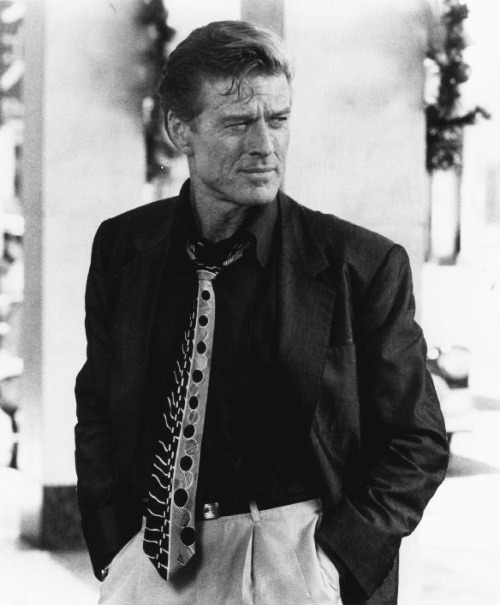

Batista's closest friend in the Mafia was Lansky. They formed a renowned friendship and business relationship that lasted for a decade. During a stay at the Waldorf-Astoria in New York in the late 1940s, it was mutually agreed upon that, in exchange for kickbacks, Batista would offer Lansky and the Mafia control of Havana’s racetracks and casinos. Batista would open Havana to large scale gambling, and his government would match, dollar for dollar, any hotel investment over $1 million, which would include a casino license. Lansky would place himself at the center of Cuba's gambling operations. He immediately called on his associates to hold a summit in Havana.
The Havana Conference was held on December 22, 1946 at the Hotel Nacional. This was the first full-scale meeting of American underworld leaders since the Chicago meeting in 1932. Present were such figures as Joe Adonis and Albert "The Mad Hatter" Anastasia,
and Albert "The Mad Hatter" Anastasia, Frank Costello,
Frank Costello, Joseph "Joe Bananas" Bonanno, Vito Genovese, Moe Dalitz,
Joseph "Joe Bananas" Bonanno, Vito Genovese, Moe Dalitz,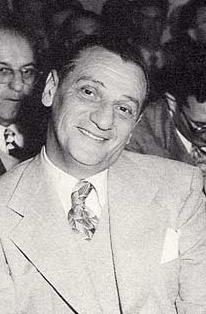 Thomas Luchese, from New York, Santo Trafficante Jr. from Tampa, Carlos Marcello from New Orleans, and Stefano Magaddino, Joe Bonanno's cousin from Buffalo. From Chicago there were Anthony Accardo and the Fischetti brothers, "Trigger-Happy" Charlie
Thomas Luchese, from New York, Santo Trafficante Jr. from Tampa, Carlos Marcello from New Orleans, and Stefano Magaddino, Joe Bonanno's cousin from Buffalo. From Chicago there were Anthony Accardo and the Fischetti brothers, "Trigger-Happy" Charlie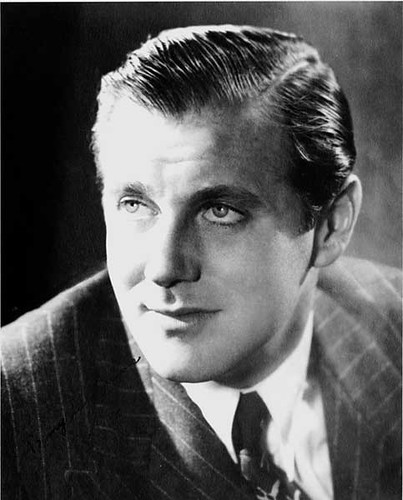 and Rocco, and, representing the Jewish interest, Lansky, Dalitz and "Dandy" Phil Kastel from Florida. The first to arrive was Lucky Luciano, who had been deported to Italy, and had to travel to Havana with a false passport. Lansky shared with them his vision of a new Havana, profitable for those willing to invest the right sum of money. According to Luciano’s evidence, and he is the only one who ever recounted details of the events in any detail, he confirmed that he was appointed as kingpin for the mob, to rule from Cuba until such time as he could find a legitimate way back into the U.S. Entertainment at the conference was provided by, among others, Frank Sinatra
and Rocco, and, representing the Jewish interest, Lansky, Dalitz and "Dandy" Phil Kastel from Florida. The first to arrive was Lucky Luciano, who had been deported to Italy, and had to travel to Havana with a false passport. Lansky shared with them his vision of a new Havana, profitable for those willing to invest the right sum of money. According to Luciano’s evidence, and he is the only one who ever recounted details of the events in any detail, he confirmed that he was appointed as kingpin for the mob, to rule from Cuba until such time as he could find a legitimate way back into the U.S. Entertainment at the conference was provided by, among others, Frank Sinatra  who flew down to Cuba with their friends, the Fischetti brothers.
who flew down to Cuba with their friends, the Fischetti brothers.
In 1952, Lansky even offered then President Carlos Prío Socarrás a bribe of U.S. $250,000 to step down so Batista could return to power. Once Batista retook control of the government he quickly put gambling back on track. The dictator contacted Lansky and offered him an annual salary of U.S. $25,000 to serve as an unofficial gambling minister. By 1955, Batista had changed the gambling laws once again, granting a gaming license to anyone who invested $1 million in a hotel or U.S. $200,000 in a new nightclub. Unlike the procedure for acquiring gaming licenses in Vegas, this provision exempted venture capitalists from background checks. As long as they made the required investment, they were provided with public matching funds for construction, a 10-year tax exemption and duty-free importation of equipment and furnishings. The government would get U.S. $250,000 for the license plus a percentage of the profits from each casino. Cuba’s 10,000 slot machines, even the ones which dispensed small prizes for children at country fairs, were to be the province of Batista's brother-in-law, Roberto Fernandez y Miranda. An Army general and government sports director, Fernandez was also given the parking meters in Havana as a little something extra. Import duties were waived on materials for hotel construction and Cuban contractors with the right "in" made windfalls by importing much more than was needed and selling the surplus to others for hefty profits. It was rumored that besides the U.S. $250,000 to get a license, sometimes more was required under the table. Periodic payoffs were requested and received by corrupt politicians.
a bribe of U.S. $250,000 to step down so Batista could return to power. Once Batista retook control of the government he quickly put gambling back on track. The dictator contacted Lansky and offered him an annual salary of U.S. $25,000 to serve as an unofficial gambling minister. By 1955, Batista had changed the gambling laws once again, granting a gaming license to anyone who invested $1 million in a hotel or U.S. $200,000 in a new nightclub. Unlike the procedure for acquiring gaming licenses in Vegas, this provision exempted venture capitalists from background checks. As long as they made the required investment, they were provided with public matching funds for construction, a 10-year tax exemption and duty-free importation of equipment and furnishings. The government would get U.S. $250,000 for the license plus a percentage of the profits from each casino. Cuba’s 10,000 slot machines, even the ones which dispensed small prizes for children at country fairs, were to be the province of Batista's brother-in-law, Roberto Fernandez y Miranda. An Army general and government sports director, Fernandez was also given the parking meters in Havana as a little something extra. Import duties were waived on materials for hotel construction and Cuban contractors with the right "in" made windfalls by importing much more than was needed and selling the surplus to others for hefty profits. It was rumored that besides the U.S. $250,000 to get a license, sometimes more was required under the table. Periodic payoffs were requested and received by corrupt politicians.
Lansky set about reforming the Montmart
Albert Tannenbaum (January 17, 1906 - November, 1976), nicknamed Allie or Tick-Tock, was a Jewish-American hitman for Murder, Inc., the enforcement arm of the National Crime Syndicate, during the 1930s.
 Tannenbaum was born in Nanticoke, Pennsylvania, to Sam and Anna Tannenbaum (née Schwartz), and moved to the Lower East Side of Manhattan at the age of three; his family later relocated to Brooklyn. He quit school at the age of 17 to work as a stock boy in the garment district
Tannenbaum was born in Nanticoke, Pennsylvania, to Sam and Anna Tannenbaum (née Schwartz), and moved to the Lower East Side of Manhattan at the age of three; his family later relocated to Brooklyn. He quit school at the age of 17 to work as a stock boy in the garment district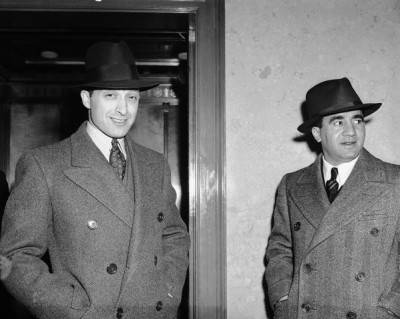 . After a stint as a salesman, he began work at the Loch Sheldrake Country Club, which was owned by his father. When Tannenbaum was 25, he met a guest at the club by the name of Jacob "Gurrah" Shapiro, a close associate of infamous Jewish gangster Lepke Buchalter.
. After a stint as a salesman, he began work at the Loch Sheldrake Country Club, which was owned by his father. When Tannenbaum was 25, he met a guest at the club by the name of Jacob "Gurrah" Shapiro, a close associate of infamous Jewish gangster Lepke Buchalter. Shapiro felt that Tannenbaum had what it took to become a mob hitman, and introduced him to the underworld.
Shapiro felt that Tannenbaum had what it took to become a mob hitman, and introduced him to the underworld.
Tannenbaum progressed rapidly through the ranks of organized criminal violence. He began as an enforcer and strikebreaker being paid $50 a week; his salary was raised to $75 and then later to $100. When he became a full-fledged contract killer in Murder, Inc., he was paid $125 a week for his services.
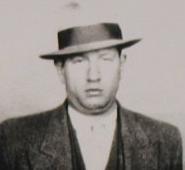 nicknamed "Big Greenie", in Los Angeles on November 22, 1939. Tannenbaum had been assigned to the hit by Buchalter, who at the time was on the lam from New York District Attorney Thomas E. Dewey and was trying to eliminate potential witnesses that Dewey could use. Tannenbaum followed Greenberg first to Montreal and then to Detroit before finally catching up to him in Los Angeles and killing him under the supervision of (and with the assistance of) the Syndicate's West Coast representative, Bugsy Siegel.
nicknamed "Big Greenie", in Los Angeles on November 22, 1939. Tannenbaum had been assigned to the hit by Buchalter, who at the time was on the lam from New York District Attorney Thomas E. Dewey and was trying to eliminate potential witnesses that Dewey could use. Tannenbaum followed Greenberg first to Montreal and then to Detroit before finally catching up to him in Los Angeles and killing him under the supervision of (and with the assistance of) the Syndicate's West Coast representative, Bugsy Siegel. Tannenbaum's slaying of Greenberg is generally regarded as the first-ever mob assassination in Southern California.
Tannenbaum's slaying of Greenberg is generally regarded as the first-ever mob assassination in Southern California.
However, in 1940, under pressure from Brooklyn authorities, Tannenbaum became a "stool pigeon" himself, testifying in Buchalter's trial about the involvement of Lepke and Charles Workman in the murder of Dutch Schultz, among others.
In 1950, Tannenbaum testified in the murder trial of Jack Parisi. The article states that Tanenbaum lived in Atlanta.(N.Y. Times March 30, 1950, "Murder Witness Back, Accuser of Lepke Will Testify Against Another Suspect").
Unable to return to US soil, except for the allowed one time per year, Tannenbaum died off the coast of Florida in 1976.
The Montmartre Club, which soon became the "in" place in Havana. He also long expressed an interest in putting a casino in the elegant Hotel Nacional, which overlooked El Morro, the ancient fortress guarding Havana harbor.
the ancient fortress guarding Havana harbor. Lansky planned to take a wing of the 10-storey hotel and create luxury suites for high-stakes players. Batista endorsed Lansky’s idea over the objections of American expatriates such as Ernest Hemingway and the elegant hotel opened for business in 1955 with a show by Eartha Kitt. The casino was an immediate success.
Lansky planned to take a wing of the 10-storey hotel and create luxury suites for high-stakes players. Batista endorsed Lansky’s idea over the objections of American expatriates such as Ernest Hemingway and the elegant hotel opened for business in 1955 with a show by Eartha Kitt. The casino was an immediate success.
Once all the new hotels, nightclubs and casinos had been built Batista wasted no time collecting his share of the profits. Nightly, the "bagman" for his wife collected 10 percent of the profits at Trafficante's interests; the Sans Souci cabaret, and the casinos in the hotels Sevilla-Biltmore, Commodoro, Deauville and Capri (part-owned by the actor George Raft). His take from the Lansky casinos, his prized Habana Riviera, the Nacional, the Montmartre Club and others, was said to be 30 percent. What exactly Batista and his cronies actually received in total in the way of bribes, payoffs and profiteering has never been certified. The slot machines alone contributed approximately U.S. $1 million to the regime's bank account.
The 1959 Cuban revolution and the rise of Fidel Castro changed the climate for mob investment in 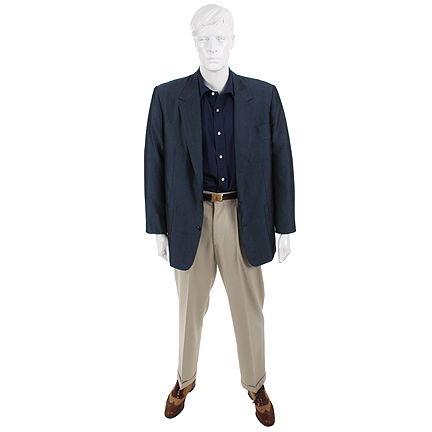 Cuba. On that New Year's Eve of 1958, while Batista was preparing to flee to the Dominican Republic
Cuba. On that New Year's Eve of 1958, while Batista was preparing to flee to the Dominican Republic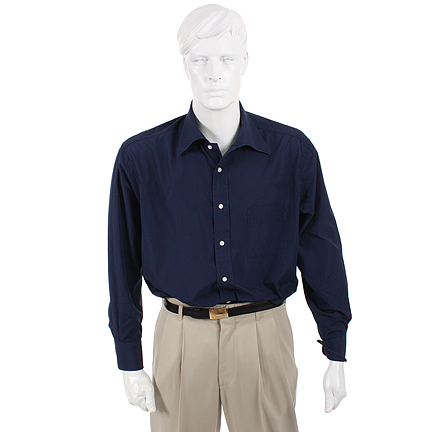 and then on to Spain (where he died in exile in 1973), Lansky was celebrating the $3 million he made
and then on to Spain (where he died in exile in 1973), Lansky was celebrating the $3 million he made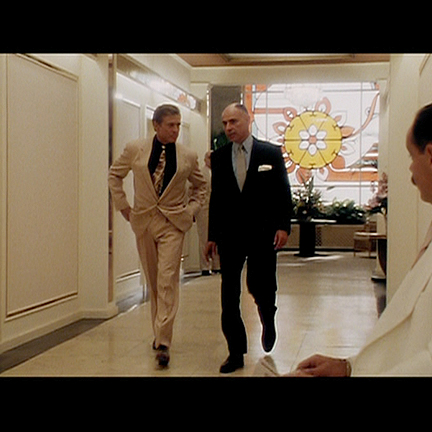 in the first year of operations at his 440-room, $18 million palace, the Habana Riviera. Many of the
in the first year of operations at his 440-room, $18 million palace, the Habana Riviera. Many of the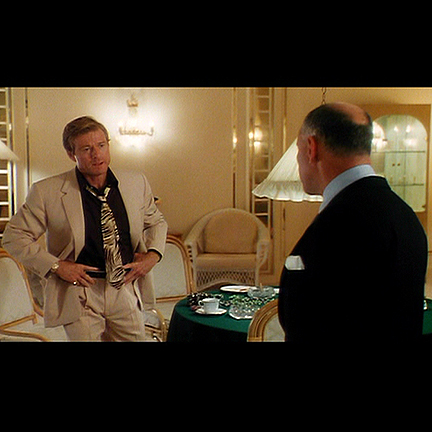 casinos, including several of Lansky's, were looted and destroyed that night.
casinos, including several of Lansky's, were looted and destroyed that night.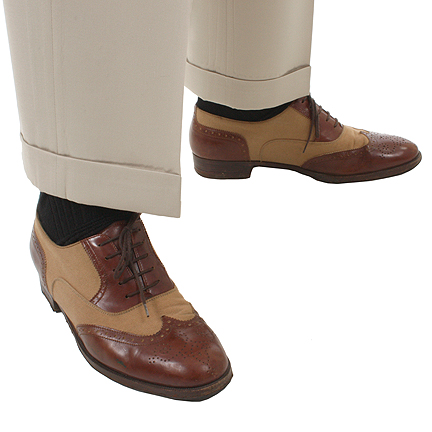
On January 8, 1959, Castro marched into Havana and took over, setting up shop in the Hilton. Lansky had fled the day before for the Bahamas and other Caribbean destinations.
had fled the day before for the Bahamas and other Caribbean destinations. The new Cuban president, Manuel Urrutia Lleó,
The new Cuban president, Manuel Urrutia Lleó, took steps to close the casinos.
took steps to close the casinos.
In October 1960, Castro nationalized the island's hotel-casinos and outlawed gambling. This action essentially wiped out Lansky's asset base and revenue streams. He lost an estimated $7 million. With the additional crackdown on casinos in Miami, Lansky was forced to depend on his Las Vegas revenues.
In his later years, Lansky lived a low-profile, routine existence in Miami Beach.  He dressed like the average grandfather, walked his dog every morning, and portrayed himself as a harmless retiree. Lansky's associates usually met him in malls and other crowded locations. Lansky would change drivers, who chauffeured him around town to look for new pay phones almost every day.
He dressed like the average grandfather, walked his dog every morning, and portrayed himself as a harmless retiree. Lansky's associates usually met him in malls and other crowded locations. Lansky would change drivers, who chauffeured him around town to look for new pay phones almost every day.
In 1970, Lansky fled to Herzliya Pituah, Israel, to escape federal tax evasion charges. Although the Israeli Law of Return allows any Jew to settle in the State of Israel, it excludes those with criminal pasts. Two years after Lansky fled to Israel, Israeli authorities deported him back to the U.S. The U.S. government brought Lansky to trial with the testimony of loan shark Vincent "Fat Vinnie" Teresa, an informant with little or no credibility. Lansky was acquitted in 1974.
to escape federal tax evasion charges. Although the Israeli Law of Return allows any Jew to settle in the State of Israel, it excludes those with criminal pasts. Two years after Lansky fled to Israel, Israeli authorities deported him back to the U.S. The U.S. government brought Lansky to trial with the testimony of loan shark Vincent "Fat Vinnie" Teresa, an informant with little or no credibility. Lansky was acquitted in 1974.
The word ugly is Middle-English in origin, deriving from a Norse word meaning unpleasant or repulsive. It can also mean threatening or dangerous, adjectives that aptly describe so many of the people who populated the American underworld.Joe Barboza was definitely one such man. There were some people who Joe didn’t scare. There's the time in 1965 when Joseph Elmer McCain, one of the toughest cops ever in Boston, arrested Joe Barboza, for beating up a patron at The Ebb Tide bar in Revere Beach. In the jail, Barboza insulted McCain, saying he wasn't so tough without his gun. On the spot, the cop unbuckled his gun and nightstick, stepped in the cell, and invited Barboza to take a shot. He declined, and McCain said, I thought so.
There were some people who Joe didn’t scare. There's the time in 1965 when Joseph Elmer McCain, one of the toughest cops ever in Boston, arrested Joe Barboza, for beating up a patron at The Ebb Tide bar in Revere Beach. In the jail, Barboza insulted McCain, saying he wasn't so tough without his gun. On the spot, the cop unbuckled his gun and nightstick, stepped in the cell, and invited Barboza to take a shot. He declined, and McCain said, I thought so.
Lansky's last years were spent quietly at his home in Miami Beach. He died of lung cancer on January 15, 1983, age 80, leaving behind a widow and three children.On paper, Lansky was worth almost nothing. At the time, the FBI believed he left behind over $300 million in hidden bank accounts, but they never found any money.
However, his biographer Robert Lacey describes Lansky's financially strained circumstances in the last two decades of his life and his inability to pay for health care for his relatives. For Lacey, there was no evidence "to sustain the notion of Lansky as king of all evil, the brains, the secret mover, the inspirer and controller of American organized crime." He concludes from evidence including interviews with the surviving members of the family that Lansky's wealth and influence had been grossly exaggerated, and that it would be more accurate to think of him as an accountant for gangsters rather than a gangster himself. His granddaughter told author T.J. English that at his death in 1983, Lansky left only $37,000 in cash. When asked in his later years what went wrong in Cuba, the gangster offered no excuses. "I crapped out," he said. Lansky even went as far as to tell people he had lost almost every penny in Cuba and that he was barely scraping by. In all likelihood, it was only an excuse to keep the IRS off his back. According to Lansky's daughter Sandra, he had transferred at least $15 million to his brother Jake due to his problems with the IRS. In fact, all of his men seemed to have more money than him.
When asked in his later years what went wrong in Cuba, the gangster offered no excuses. "I crapped out," he said. Lansky even went as far as to tell people he had lost almost every penny in Cuba and that he was barely scraping by. In all likelihood, it was only an excuse to keep the IRS off his back. According to Lansky's daughter Sandra, he had transferred at least $15 million to his brother Jake due to his problems with the IRS. In fact, all of his men seemed to have more money than him.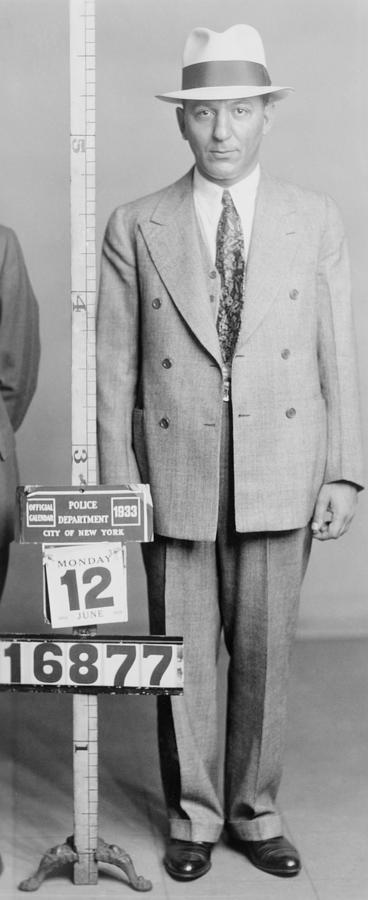 They owned hotels, restaurants, nightclubs, stocks and bonds and some like Sam Cohen and Alvin Malnik, even owned banks.
They owned hotels, restaurants, nightclubs, stocks and bonds and some like Sam Cohen and Alvin Malnik, even owned banks. "Meyer Lansky doesn't own property. He owns people." said Hank Messick, a journalist for the Miami Herald who had spent years investigating the character. Messick, the FBI and legendary District Attorney,
"Meyer Lansky doesn't own property. He owns people." said Hank Messick, a journalist for the Miami Herald who had spent years investigating the character. Messick, the FBI and legendary District Attorney,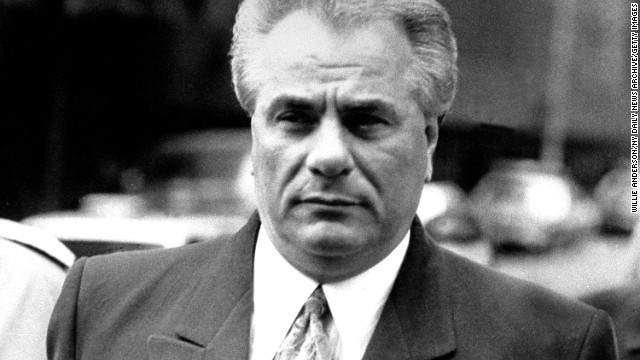 Robert Morgenthau all believed Lansky had kept large sums of money in other people's names for decades and that keeping very little in his own was nothing new to him. If Lansky's low-key demeanor was fooling many people, it certainly was not fooling the FBI. He was treated like royalty wherever he went and the way some of the most powerful people in Miami conducted themselves around him was enough for them to keep him on the radar until his dying day. The truth regarding Lansky's wealth and influence remains a mystery.
Robert Morgenthau all believed Lansky had kept large sums of money in other people's names for decades and that keeping very little in his own was nothing new to him. If Lansky's low-key demeanor was fooling many people, it certainly was not fooling the FBI. He was treated like royalty wherever he went and the way some of the most powerful people in Miami conducted themselves around him was enough for them to keep him on the radar until his dying day. The truth regarding Lansky's wealth and influence remains a mystery.
Roth's statement to Michael Corleone that "We're bigger than U.S. Steel" was actually a direct quote from Lansky, who said the same thing to his wife while watching a news story on the Cosa Nostra. The character Johnny Ola is similar to Lansky's associate Vincent Alo. Additionally, the character .

"Shadowland" is a revelatory and dramatic true-life thriller spanning much of the twentieth century, a page-turning chronicle of an elaborate Mafia plan to 'invade' Europe using 1960s London as a bridgehead. The capital city of the Swinging Sixties
 was also a world of gambling, guns and gangsters. Several veterans of the era are astonished that they survived it and some feel protected enough - now that most of the killers are themselves dead - to reveal to bestselling author Douglas Thompson the details and secrets of one of history's greatest criminal conspiracies, and of how world-champion boxer Freddie Mills really died. The tension in this real-life narrative is ferocious as the tale moves from London to New York and Las Vegas,
was also a world of gambling, guns and gangsters. Several veterans of the era are astonished that they survived it and some feel protected enough - now that most of the killers are themselves dead - to reveal to bestselling author Douglas Thompson the details and secrets of one of history's greatest criminal conspiracies, and of how world-champion boxer Freddie Mills really died. The tension in this real-life narrative is ferocious as the tale moves from London to New York and Las Vegas,  down to Miami, into Havana, then on to the Bahamas and back to an unexpected denouement in London. Brutal, terrifying and intrigue-packed
down to Miami, into Havana, then on to the Bahamas and back to an unexpected denouement in London. Brutal, terrifying and intrigue-packed , it is an account of the Mob's Machiavellian global manipulation of governments and officials. "Shadowland" recounts events from the viewpoint of the pawns as well as the kingmakers.
, it is an account of the Mob's Machiavellian global manipulation of governments and officials. "Shadowland" recounts events from the viewpoint of the pawns as well as the kingmakers.  All the big players of Mafia history are here, controlled by the gangster genius Meyer Lansky, but so are the hit men, the fixers, the hoodlums and the wiseguys.
All the big players of Mafia history are here, controlled by the gangster genius Meyer Lansky, but so are the hit men, the fixers, the hoodlums and the wiseguys.
 Here is the corner of Old Compton and Frith Street in 1976. The Continental Fruit Stores, scene of the infamous fight between local tough guys Albert Dimes and Jack Spot
Here is the corner of Old Compton and Frith Street in 1976. The Continental Fruit Stores, scene of the infamous fight between local tough guys Albert Dimes and Jack Spot  in the 1950s
in the 1950s At this point the British government stepped in with a series of expulsions. The most that can be said of the American 'Mafia' or syndicate involvement in London gambling after 1969 is that some groups may have maintained a surreptitious interest and kept a small skim operation operating somewhere. But… the Gaming Board and the local Licensing Justices were normally prepared to crush vigorously the slightest sign of malfeasance.
George Ranft, began life in the Hell’s Kitchen section of New York City, a neighborhood that necessitated the development of the “tough guy” image which would serve him so well in later years.
 He tried prizefighting for a time, but eventually gave it up in favor of much less violent pursuits. Showing a great interest
He tried prizefighting for a time, but eventually gave it up in favor of much less violent pursuits. Showing a great interest  and aptitude for dance, the dashing young man found himself working in some of New York City’s most fashionable nightclubs.
and aptitude for dance, the dashing young man found himself working in some of New York City’s most fashionable nightclubs.  He earned a spot in the stage act of Texas Guinan and eventually landed on Broadway.
He earned a spot in the stage act of Texas Guinan and eventually landed on Broadway. 
While working in the nightclubs, George was introduced to the world of organized crime, an association that would last throughout his life, but he was soon hearing the siren call of Hollywood
 and he left New York behind for the movie business. He arrived in Hollywood in 1928 and took a succession of small roles until his
and he left New York behind for the movie business. He arrived in Hollywood in 1928 and took a succession of small roles until his breakout performance in 1932’s “Scarface”. Playing Guino Rinaldo, the cool-headed henchman to Paul
breakout performance in 1932’s “Scarface”. Playing Guino Rinaldo, the cool-headed henchman to Paul Muni’s Tony Camonte, Raft stood out with his toned down, well crafted performance.
Muni’s Tony Camonte, Raft stood out with his toned down, well crafted performance.By 1967, Raft's underworld
 connections caught up with him again and he was banned from England. He had been there in association with the
connections caught up with him again and he was banned from England. He had been there in association with the George Raft's Colony Sports Club (a gambling establishment) in London as the club's host, although it was supposedly owned by mobster Meyer Lansky. When Raft
George Raft's Colony Sports Club (a gambling establishment) in London as the club's host, although it was supposedly owned by mobster Meyer Lansky. When Raft  left for a brief trip back to California, he was informed that he would not be allowed back into the country.
left for a brief trip back to California, he was informed that he would not be allowed back into the country.  He did not fight the ban, but called it a "surprising body blow." It was not the first time Raft
He did not fight the ban, but called it a "surprising body blow." It was not the first time Raft had been in trouble for gambling; in 1944 he had been investigated by the LA district attorney over a dice game with an airplane parts manufacturer in which he supposedly won $10,000. Raft
had been in trouble for gambling; in 1944 he had been investigated by the LA district attorney over a dice game with an airplane parts manufacturer in which he supposedly won $10,000. Raft always maintained that the underworld connections were just acquaintances. "I've never been locked up, I've never taken a drink, I never hurt anybody,
always maintained that the underworld connections were just acquaintances. "I've never been locked up, I've never taken a drink, I never hurt anybody, and I gave all my money away. So how come I got this bum reputation?"
and I gave all my money away. So how come I got this bum reputation?"
Meyer Lansky known as the "Mob's Accountant," was a Russian-born American organized crime
 figure who, along with his associate Charles "Lucky" Luciano, was instrumental in the development of the
figure who, along with his associate Charles "Lucky" Luciano, was instrumental in the development of the "National Crime Syndicate" in the United States. For decades he was thought to be one of the most powerful people in the country.
"National Crime Syndicate" in the United States. For decades he was thought to be one of the most powerful people in the country.
Lansky developed a gambling empire which stretched from Saratoga, New York to Miami to Council Bluffs, Iowa
 and Las Vegas; it is also said that he oversaw gambling concessions in Cuba. Although a member of the Jewish Mob, Lansky undoubtedly had strong influence with the Italian Mafia and played a large role in the consolidation of the criminal underworld (although the full extent of this role has been the subject of some debate).
and Las Vegas; it is also said that he oversaw gambling concessions in Cuba. Although a member of the Jewish Mob, Lansky undoubtedly had strong influence with the Italian Mafia and played a large role in the consolidation of the criminal underworld (although the full extent of this role has been the subject of some debate).Lansky was born Meyer Suchowljansky in Grodno
 (then in Russia, now in Belarus), to a Jewish family who, he claimed, experienced pogroms.In 1911, he emigrated to the United States through the port of Odessa
(then in Russia, now in Belarus), to a Jewish family who, he claimed, experienced pogroms.In 1911, he emigrated to the United States through the port of Odessa  with his mother and brother and joined his father, who had previously emigrated to the United States in 1909, and settled on the Lower East Side of Manhattan, New York.
with his mother and brother and joined his father, who had previously emigrated to the United States in 1909, and settled on the Lower East Side of Manhattan, New York.Lansky met Bugsy Siegel
 when they were teenagers. They became lifelong friends, as well as partners in the bootlegging trade, and together with Lucky Luciano, formed a lasting partnership.
when they were teenagers. They became lifelong friends, as well as partners in the bootlegging trade, and together with Lucky Luciano, formed a lasting partnership. Lansky was instrumental in Luciano's rise to power by organizing the 1931 murder of Mafia powerhouse Salvatore Maranzano. As a youngster, Siegel saved Lansky's life several times, a fact which Lansky always appreciated. The two adroitly managed the Bugs and Meyer Mob despite its reputation as one of the most violent Prohibition gangs.
Lansky was instrumental in Luciano's rise to power by organizing the 1931 murder of Mafia powerhouse Salvatore Maranzano. As a youngster, Siegel saved Lansky's life several times, a fact which Lansky always appreciated. The two adroitly managed the Bugs and Meyer Mob despite its reputation as one of the most violent Prohibition gangs.Allen Smiley, a former Hollywood producer turned gangster, and his daughter, Lily. Smiley was “Bugsy” Siegel’s best friend and business partner, and was seated next to Benny the night he was murdered. He became an upper-echelon representative of Meyer Lansky’s criminal empire.Lansky was the brother of Jacob "Jake" Lansky, who in 1959 was the manager of the Nacional Hotel in Havana, Cuba.
 First of all, and last of all, Allen Smiley was Bugsy Siegel’s friend. In a sense, he was Bugsy’s shadow. When you saw one, you usually saw the other The hitman that shot Bugsy Siegel saw them together too…
First of all, and last of all, Allen Smiley was Bugsy Siegel’s friend. In a sense, he was Bugsy’s shadow. When you saw one, you usually saw the other The hitman that shot Bugsy Siegel saw them together too…  arnold rothstein
arnold rothsteinArnold Rothstein (January 17, 1882 – November 5, 1928), nicknamed "the Brain," was a Jewish New York racketeer, businessman and gambler who became a kingpin of the Jewish mob in New York. Rothstein was widely reputed to have
 organized corruption in professional athletics, most notoriously conspiring in the fixing of the 1919 World Series Black Sox Scandal.
organized corruption in professional athletics, most notoriously conspiring in the fixing of the 1919 World Series Black Sox Scandal.
According to the crime writer Leo Katcher, Rothstein "transformed organized crime from a thuggish activity by hoodlums into a big business, run like a corporation, with himself at the top." According to Rich Cohen, Rothstein was the person who first realized that Prohibition was a business opportunity, a means to enormous wealth, who "understood the truths of early century capitalism and came to dominate them."His notoriety inspired several fictional characters based on his life, portrayed in contemporary and later short stories, novels, musicals and films.
..
By the time Titanic Thompson (above) was called as a witness in the 1929 murder trial of Rothsteinhe was the most infamous and itinerant hustler in American history. He’d won millions playing poker and shooting craps, had slain four men, wed three women and earned his Sergeant’s stripes in the army. He’d gambled with gangsters, danced with dames and had conned, wrangled, lied and fled in every state in America. What’s more, he’d done it without booze or fags, having promised his Mother he would never smoke or drink.
when Assistant District Attorney Ferdinand Pecora asked him to explain to the courtroom what he did for a living, the answer, “I play a little golf for money,” is perhaps one of the biggest understatements of the 20th century. It is not, however, a direct lie. Somehow, in between all of his countless shenanigans, Thompson did play golf for money. Shedloads of it.
.
.
"Bugsy and Smiley were both seated on the same couch when the Slugger blasted Bugsy to smithereens. Smiley dove down on the floor, and he ended up with three bullet holes in his jacket sleeve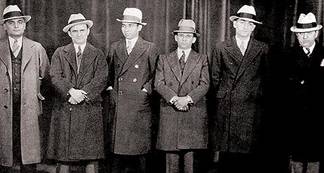

but none of them in him.
Bugsy had died , but his legend was alive and well in the person of Allen Smiley.
Fast Forward 30 years
I walked into the La Cienega Bridge Club on Pico blvd with my shylock partner Puggy Zeichick..The place was a haven for big time Jewish bookies and gamblers. Even a few hoodlums were allowed in the joint. . That would be us

But on this particular day we are meeting Danny Wilson aka James Iannone Danny was a made guy back when Pikes Peak was just a pebble. He was sitting at a table with a guy playing gin.

Like a goo-goo-eyed-groupie, Puggy says to me, ” Anthony , look, look, do you see the guy with Danny Wilson? That’s Al Smiley, Al was there with Bugsy Siegel when he got whacked” . 

I already knew that about Al. I had heard it many times before Like the time I was in Schwab’s drug store on Sunset boulevard with my cousin Mario the actor. Smiley was sitting in a booth talking to the owner Leon Schwab

After Smiley left, Leon Schwab sees us and rushes over to the counter where we are sitting and says, ” Mario , did you see that guy I was talking to.”? I stop Leon, I say, “ I bet you one of your famous coffee shakes that I know what you’re about to say” Bingo, the boy won a shake.

Al Smiley wasn’t a gangster, or mobster, those labels are stamped on tough guys. His persona was more polished than rough. It made him a fabulous front man for the Mob.. So “Organized Crime Figure” fits him better.
Al knew many of the Mob’s General’s . He was well connected with Mafia , maven, Frank Costello. He steered suckers with big bankrolls to Costello’s illegal gambling parlors for a percentage of their losses.
He was a first class felon.. On his rap sheet his repertoire of rackets included Ponzie schemes and trafficking in narcotics.
I knew Al, but not that well . He was old when I met him. His star had long since fallen, and mine was on the rise.. He was always a big gambler and sometimes he went bust. Although one day I ran into Al at the track when he was flush with cash . I knew he had just made a score with a scam artist associate of mine named Jack Fine..
Jack could sell holy water to a Vampire. They both probably sold some sucker the Brooklyn Bridge. That was the last time I saw Al .
Al Smiley died broke,.but he ended his criminal career on a high note when he beat a racketeering beef with Mob boss, Dominic Brooklier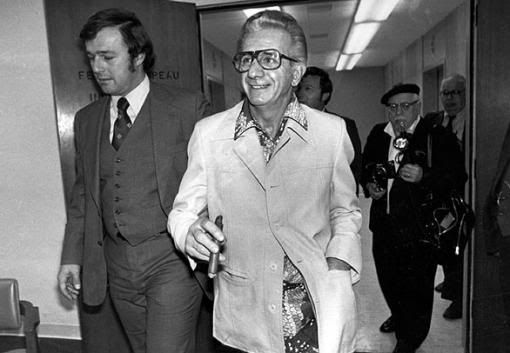 and Capo, Pete Milano… .
and Capo, Pete Milano… .
 and Capo, Pete Milano… .
and Capo, Pete Milano… .
Smiley lived in Bugsy’s shadow, but the shadow belonged to his best friend."
By 1936, Lansky had established gambling operations in Florida, New Orleans, and Cuba. These gambling operations were successful as they were founded upon two innovations:
- First, Lansky and his connections had the technical expertise to effectively manage them based upon Lansky’s knowledge of the true mathematical odds of most popular wagering games.
- Second, mob connections were used to ensure legal and physical security of their establishments from other crime figures, and law enforcement (through bribes).
In 1936, Lansky's partner Luciano was sent to prison.
Lansky later convinced the Mafia to place Bugsy Siegel in charge of Las Vegas, and became a major investor in Siegel's Flamingo Hotel.
During the 1940s, Lansky's associate Siegel persuaded the crime bosses to invest in a lavish new casino hotel project in Las Vegas, the Flamingo. After long delays and large cost overruns, the Flamingo Hotel was still not open for business. To discuss the Flamingo problem, the Mafia investors attended a secret meeting in Havana, Cuba in 1946.
 While the other bosses wanted to kill Siegel, Lansky begged them to give his friend a second chance. Despite this reprieve, Siegel continued to lose Mafia money on the Flamingo Hotel. A second family meeting was then called. However, by the time this meeting took place, the casino turned a small profit. Lansky again, with Luciano's support, convinced the family to give Siegel some more time.
While the other bosses wanted to kill Siegel, Lansky begged them to give his friend a second chance. Despite this reprieve, Siegel continued to lose Mafia money on the Flamingo Hotel. A second family meeting was then called. However, by the time this meeting took place, the casino turned a small profit. Lansky again, with Luciano's support, convinced the family to give Siegel some more time.The Flamingo was soon losing money again. At a third meeting, the family decided that Siegel was finished. It is widely believed that Lansky himself was compelled to give the final okay on eliminating Siegel due to his long relationship with Siegel and his stature in the family.
On June 20, 1947, Siegel was shot and killed in Beverly Hills, California. Twenty minutes after the Siegel hit, Lansky's associates, including Gus Greenbaum
After Siegel's murder in June 1947, Greenbaum brought the struggling casino out of debt within several months, controlling several other syndicate casinos and bookmaking operations in Arizona within several years. Greenbaum planned to retire to Arizona and rejected offers to run the Riviera for Tony Accardo, though after Greenbaum's sister-in-law was murdered, he accepted the job. As a syndicate leader in Las Vegas, Greenbaum would order the deaths of Tony Brancato and Tony Trombino for robbing a syndicate hotel. Shortly after his close friend and Chicago-enemy Willie Bioff's murder, Greenbaum's now worsening gambling, womanizing, and drug habits eventually caused him to begin skimming from casino operations. His embezzlement was discovered by the Chicago syndicate. On December 3, 1958, Greenbaum and his wife Bess were found dead in their (below) Phoenix home. Their throats had been cut with a butcher knife. Gus was found in bed with a heating pad and his television turned on. He had nearly been decapitated. Bess sustained blunt trauma to her head before her throat was cut. Her head was padded with newspaper and a towel, seemingly to avoid blood stains on the furniture.
 and Moe Sedway, walked into the Flamingo Hotel and took control of the property. According to the Federal Bureau of Investigation, Lansky retained a substantial financial interest in the Flamingo for the next twenty years. Lansky said in several interviews later in his life that if it had been up to him, "... Ben Siegel would be alive today."
and Moe Sedway, walked into the Flamingo Hotel and took control of the property. According to the Federal Bureau of Investigation, Lansky retained a substantial financial interest in the Flamingo for the next twenty years. Lansky said in several interviews later in his life that if it had been up to him, "... Ben Siegel would be alive today."This also marked a power transfer in Vegas from the New York crime families to the Chicago Outfit. Although his role was considerably more restrained than in previous years, Lansky is believed to have both advised and aided Chicago boss Tony Accardo in initially establishing his hold.
After Al Capone's 1931 conviction for tax evasion and prostitution, Lansky saw that he too was vulnerable to a similar prosecution. To protect himself, he transferred the illegal earnings from his growing casino empire to a Swiss numbered bank account, whose anonymity was assured by the 1934 Swiss Banking Act. Lansky eventually even bought an offshore bank in Switzerland, which he used to launder money through a network of shell and holding companies.
In the 1930s, Meyer Lansky and his gang claimed to have stepped outside their usual criminal activities to break up rallies held by Nazi sympathizers. Lansky recalled a particular rally in Yorkville,
 a German neighborhood in Manhattan, that he claimed he and 14 other associates disrupted:
a German neighborhood in Manhattan, that he claimed he and 14 other associates disrupted:- The stage was decorated with a swastika and a picture of Adolf Hitler. The speakers started ranting. There were only fifteen of us, but we went into action. We threw some of them out the windows. Most of the Nazis panicked and ran out. We chased them and beat them up. We wanted to show them that Jews would not always sit back and accept insults.
According to Luciano's authorized biography, during this time, Lansky helped arrange a deal with the U.S. Government via a high-ranking U.S. Navy official. This deal would secure the release of Luciano from prison; in exchange, the Italian Mafia would provide security for the war ships that were being built along the docks in New York Harbor. German submarines were sinking Allied shipping outside the coast on a daily basis and there was great fear of attack or sabotage by Nazi sympathizers

After World War II, Lansky associate Lucky Luciano was paroled from prison on the condition that he permanently return to Sicily. However, Luciano secretly moved to Cuba, where he worked to resume control over American Mafia operations. Luciano also ran a number of casinos in Cuba with the sanction of Cuban president General Fulgencio Batista, though the US government succeeded in pressuring the Batista regime to deport Luciano.

Batista's closest friend in the Mafia was Lansky. They formed a renowned friendship and business relationship that lasted for a decade. During a stay at the Waldorf-Astoria in New York in the late 1940s, it was mutually agreed upon that, in exchange for kickbacks, Batista would offer Lansky and the Mafia control of Havana’s racetracks and casinos. Batista would open Havana to large scale gambling, and his government would match, dollar for dollar, any hotel investment over $1 million, which would include a casino license. Lansky would place himself at the center of Cuba's gambling operations. He immediately called on his associates to hold a summit in Havana.
The Havana Conference was held on December 22, 1946 at the Hotel Nacional. This was the first full-scale meeting of American underworld leaders since the Chicago meeting in 1932. Present were such figures as Joe Adonis
 and Albert "The Mad Hatter" Anastasia,
and Albert "The Mad Hatter" Anastasia, Frank Costello,
Frank Costello, Joseph "Joe Bananas" Bonanno, Vito Genovese, Moe Dalitz,
Joseph "Joe Bananas" Bonanno, Vito Genovese, Moe Dalitz, Thomas Luchese, from New York, Santo Trafficante Jr. from Tampa, Carlos Marcello from New Orleans, and Stefano Magaddino, Joe Bonanno's cousin from Buffalo. From Chicago there were Anthony Accardo and the Fischetti brothers, "Trigger-Happy" Charlie
Thomas Luchese, from New York, Santo Trafficante Jr. from Tampa, Carlos Marcello from New Orleans, and Stefano Magaddino, Joe Bonanno's cousin from Buffalo. From Chicago there were Anthony Accardo and the Fischetti brothers, "Trigger-Happy" Charlie and Rocco, and, representing the Jewish interest, Lansky, Dalitz and "Dandy" Phil Kastel from Florida. The first to arrive was Lucky Luciano, who had been deported to Italy, and had to travel to Havana with a false passport. Lansky shared with them his vision of a new Havana, profitable for those willing to invest the right sum of money. According to Luciano’s evidence, and he is the only one who ever recounted details of the events in any detail, he confirmed that he was appointed as kingpin for the mob, to rule from Cuba until such time as he could find a legitimate way back into the U.S. Entertainment at the conference was provided by, among others, Frank Sinatra
and Rocco, and, representing the Jewish interest, Lansky, Dalitz and "Dandy" Phil Kastel from Florida. The first to arrive was Lucky Luciano, who had been deported to Italy, and had to travel to Havana with a false passport. Lansky shared with them his vision of a new Havana, profitable for those willing to invest the right sum of money. According to Luciano’s evidence, and he is the only one who ever recounted details of the events in any detail, he confirmed that he was appointed as kingpin for the mob, to rule from Cuba until such time as he could find a legitimate way back into the U.S. Entertainment at the conference was provided by, among others, Frank Sinatra  who flew down to Cuba with their friends, the Fischetti brothers.
who flew down to Cuba with their friends, the Fischetti brothers.In 1952, Lansky even offered then President Carlos Prío Socarrás
 a bribe of U.S. $250,000 to step down so Batista could return to power. Once Batista retook control of the government he quickly put gambling back on track. The dictator contacted Lansky and offered him an annual salary of U.S. $25,000 to serve as an unofficial gambling minister. By 1955, Batista had changed the gambling laws once again, granting a gaming license to anyone who invested $1 million in a hotel or U.S. $200,000 in a new nightclub. Unlike the procedure for acquiring gaming licenses in Vegas, this provision exempted venture capitalists from background checks. As long as they made the required investment, they were provided with public matching funds for construction, a 10-year tax exemption and duty-free importation of equipment and furnishings. The government would get U.S. $250,000 for the license plus a percentage of the profits from each casino. Cuba’s 10,000 slot machines, even the ones which dispensed small prizes for children at country fairs, were to be the province of Batista's brother-in-law, Roberto Fernandez y Miranda. An Army general and government sports director, Fernandez was also given the parking meters in Havana as a little something extra. Import duties were waived on materials for hotel construction and Cuban contractors with the right "in" made windfalls by importing much more than was needed and selling the surplus to others for hefty profits. It was rumored that besides the U.S. $250,000 to get a license, sometimes more was required under the table. Periodic payoffs were requested and received by corrupt politicians.
a bribe of U.S. $250,000 to step down so Batista could return to power. Once Batista retook control of the government he quickly put gambling back on track. The dictator contacted Lansky and offered him an annual salary of U.S. $25,000 to serve as an unofficial gambling minister. By 1955, Batista had changed the gambling laws once again, granting a gaming license to anyone who invested $1 million in a hotel or U.S. $200,000 in a new nightclub. Unlike the procedure for acquiring gaming licenses in Vegas, this provision exempted venture capitalists from background checks. As long as they made the required investment, they were provided with public matching funds for construction, a 10-year tax exemption and duty-free importation of equipment and furnishings. The government would get U.S. $250,000 for the license plus a percentage of the profits from each casino. Cuba’s 10,000 slot machines, even the ones which dispensed small prizes for children at country fairs, were to be the province of Batista's brother-in-law, Roberto Fernandez y Miranda. An Army general and government sports director, Fernandez was also given the parking meters in Havana as a little something extra. Import duties were waived on materials for hotel construction and Cuban contractors with the right "in" made windfalls by importing much more than was needed and selling the surplus to others for hefty profits. It was rumored that besides the U.S. $250,000 to get a license, sometimes more was required under the table. Periodic payoffs were requested and received by corrupt politicians.Lansky set about reforming the Montmart
Albert Tannenbaum (January 17, 1906 - November, 1976), nicknamed Allie or Tick-Tock, was a Jewish-American hitman for Murder, Inc., the enforcement arm of the National Crime Syndicate, during the 1930s.
 Tannenbaum was born in Nanticoke, Pennsylvania, to Sam and Anna Tannenbaum (née Schwartz), and moved to the Lower East Side of Manhattan at the age of three; his family later relocated to Brooklyn. He quit school at the age of 17 to work as a stock boy in the garment district
Tannenbaum was born in Nanticoke, Pennsylvania, to Sam and Anna Tannenbaum (née Schwartz), and moved to the Lower East Side of Manhattan at the age of three; his family later relocated to Brooklyn. He quit school at the age of 17 to work as a stock boy in the garment district . After a stint as a salesman, he began work at the Loch Sheldrake Country Club, which was owned by his father. When Tannenbaum was 25, he met a guest at the club by the name of Jacob "Gurrah" Shapiro, a close associate of infamous Jewish gangster Lepke Buchalter.
. After a stint as a salesman, he began work at the Loch Sheldrake Country Club, which was owned by his father. When Tannenbaum was 25, he met a guest at the club by the name of Jacob "Gurrah" Shapiro, a close associate of infamous Jewish gangster Lepke Buchalter.Tannenbaum progressed rapidly through the ranks of organized criminal violence. He began as an enforcer and strikebreaker being paid $50 a week; his salary was raised to $75 and then later to $100. When he became a full-fledged contract killer in Murder, Inc., he was paid $125 a week for his services.

Jewish Gangsters from 1931 Joseph nig rosen bugsly siegel Harry Teitelbaum harry greenberg and louis buckhouse lepke buchablter
Perhaps the most famous murder committed by Tannenbaum as a member of Murder, Inc. was that of Harry Greenberg, nicknamed "Big Greenie", in Los Angeles on November 22, 1939. Tannenbaum had been assigned to the hit by Buchalter, who at the time was on the lam from New York District Attorney Thomas E. Dewey and was trying to eliminate potential witnesses that Dewey could use. Tannenbaum followed Greenberg first to Montreal and then to Detroit before finally catching up to him in Los Angeles and killing him under the supervision of (and with the assistance of) the Syndicate's West Coast representative, Bugsy Siegel.
nicknamed "Big Greenie", in Los Angeles on November 22, 1939. Tannenbaum had been assigned to the hit by Buchalter, who at the time was on the lam from New York District Attorney Thomas E. Dewey and was trying to eliminate potential witnesses that Dewey could use. Tannenbaum followed Greenberg first to Montreal and then to Detroit before finally catching up to him in Los Angeles and killing him under the supervision of (and with the assistance of) the Syndicate's West Coast representative, Bugsy Siegel. Tannenbaum's slaying of Greenberg is generally regarded as the first-ever mob assassination in Southern California.
Tannenbaum's slaying of Greenberg is generally regarded as the first-ever mob assassination in Southern California.However, in 1940, under pressure from Brooklyn authorities, Tannenbaum became a "stool pigeon" himself, testifying in Buchalter's trial about the involvement of Lepke and Charles Workman in the murder of Dutch Schultz, among others.
In 1950, Tannenbaum testified in the murder trial of Jack Parisi. The article states that Tanenbaum lived in Atlanta.(N.Y. Times March 30, 1950, "Murder Witness Back, Accuser of Lepke Will Testify Against Another Suspect").
Unable to return to US soil, except for the allowed one time per year, Tannenbaum died off the coast of Florida in 1976.
The Montmartre Club, which soon became the "in" place in Havana. He also long expressed an interest in putting a casino in the elegant Hotel Nacional, which overlooked El Morro,
 the ancient fortress guarding Havana harbor.
the ancient fortress guarding Havana harbor. Lansky planned to take a wing of the 10-storey hotel and create luxury suites for high-stakes players. Batista endorsed Lansky’s idea over the objections of American expatriates such as Ernest Hemingway and the elegant hotel opened for business in 1955 with a show by Eartha Kitt. The casino was an immediate success.
Lansky planned to take a wing of the 10-storey hotel and create luxury suites for high-stakes players. Batista endorsed Lansky’s idea over the objections of American expatriates such as Ernest Hemingway and the elegant hotel opened for business in 1955 with a show by Eartha Kitt. The casino was an immediate success.
Once all the new hotels, nightclubs and casinos had been built Batista wasted no time collecting his share of the profits. Nightly, the "bagman" for his wife collected 10 percent of the profits at Trafficante's interests; the Sans Souci cabaret, and the casinos in the hotels Sevilla-Biltmore, Commodoro, Deauville and Capri (part-owned by the actor George Raft). His take from the Lansky casinos, his prized Habana Riviera, the Nacional, the Montmartre Club and others, was said to be 30 percent. What exactly Batista and his cronies actually received in total in the way of bribes, payoffs and profiteering has never been certified. The slot machines alone contributed approximately U.S. $1 million to the regime's bank account.

 Cuba. On that New Year's Eve of 1958, while Batista was preparing to flee to the Dominican Republic
Cuba. On that New Year's Eve of 1958, while Batista was preparing to flee to the Dominican Republic and then on to Spain (where he died in exile in 1973), Lansky was celebrating the $3 million he made
and then on to Spain (where he died in exile in 1973), Lansky was celebrating the $3 million he made in the first year of operations at his 440-room, $18 million palace, the Habana Riviera. Many of the
in the first year of operations at his 440-room, $18 million palace, the Habana Riviera. Many of the casinos, including several of Lansky's, were looted and destroyed that night.
casinos, including several of Lansky's, were looted and destroyed that night.
On January 8, 1959, Castro marched into Havana and took over, setting up shop in the Hilton. Lansky
 had fled the day before for the Bahamas and other Caribbean destinations.
had fled the day before for the Bahamas and other Caribbean destinations. The new Cuban president, Manuel Urrutia Lleó,
The new Cuban president, Manuel Urrutia Lleó,
In October 1960, Castro nationalized the island's hotel-casinos and outlawed gambling. This action essentially wiped out Lansky's asset base and revenue streams. He lost an estimated $7 million. With the additional crackdown on casinos in Miami, Lansky was forced to depend on his Las Vegas revenues.
 He dressed like the average grandfather, walked his dog every morning, and portrayed himself as a harmless retiree. Lansky's associates usually met him in malls and other crowded locations. Lansky would change drivers, who chauffeured him around town to look for new pay phones almost every day.
He dressed like the average grandfather, walked his dog every morning, and portrayed himself as a harmless retiree. Lansky's associates usually met him in malls and other crowded locations. Lansky would change drivers, who chauffeured him around town to look for new pay phones almost every day. to escape federal tax evasion charges. Although the Israeli Law of Return allows any Jew to settle in the State of Israel, it excludes those with criminal pasts. Two years after Lansky fled to Israel, Israeli authorities deported him back to the U.S. The U.S. government brought Lansky to trial with the testimony of loan shark Vincent "Fat Vinnie" Teresa, an informant with little or no credibility. Lansky was acquitted in 1974.
to escape federal tax evasion charges. Although the Israeli Law of Return allows any Jew to settle in the State of Israel, it excludes those with criminal pasts. Two years after Lansky fled to Israel, Israeli authorities deported him back to the U.S. The U.S. government brought Lansky to trial with the testimony of loan shark Vincent "Fat Vinnie" Teresa, an informant with little or no credibility. Lansky was acquitted in 1974.The word ugly is Middle-English in origin, deriving from a Norse word meaning unpleasant or repulsive. It can also mean threatening or dangerous, adjectives that aptly describe so many of the people who populated the American underworld.Joe Barboza was definitely one such man.
 There were some people who Joe didn’t scare. There's the time in 1965 when Joseph Elmer McCain, one of the toughest cops ever in Boston, arrested Joe Barboza, for beating up a patron at The Ebb Tide bar in Revere Beach. In the jail, Barboza insulted McCain, saying he wasn't so tough without his gun. On the spot, the cop unbuckled his gun and nightstick, stepped in the cell, and invited Barboza to take a shot. He declined, and McCain said, I thought so.
There were some people who Joe didn’t scare. There's the time in 1965 when Joseph Elmer McCain, one of the toughest cops ever in Boston, arrested Joe Barboza, for beating up a patron at The Ebb Tide bar in Revere Beach. In the jail, Barboza insulted McCain, saying he wasn't so tough without his gun. On the spot, the cop unbuckled his gun and nightstick, stepped in the cell, and invited Barboza to take a shot. He declined, and McCain said, I thought so.However, his biographer Robert Lacey describes Lansky's financially strained circumstances in the last two decades of his life and his inability to pay for health care for his relatives. For Lacey, there was no evidence "to sustain the notion of Lansky as king of all evil, the brains, the secret mover, the inspirer and controller of American organized crime." He concludes from evidence including interviews with the surviving members of the family that Lansky's wealth and influence had been grossly exaggerated, and that it would be more accurate to think of him as an accountant for gangsters rather than a gangster himself. His granddaughter told author T.J. English that at his death in 1983, Lansky left only $37,000 in cash.
 When asked in his later years what went wrong in Cuba, the gangster offered no excuses. "I crapped out," he said. Lansky even went as far as to tell people he had lost almost every penny in Cuba and that he was barely scraping by. In all likelihood, it was only an excuse to keep the IRS off his back. According to Lansky's daughter Sandra, he had transferred at least $15 million to his brother Jake due to his problems with the IRS. In fact, all of his men seemed to have more money than him.
When asked in his later years what went wrong in Cuba, the gangster offered no excuses. "I crapped out," he said. Lansky even went as far as to tell people he had lost almost every penny in Cuba and that he was barely scraping by. In all likelihood, it was only an excuse to keep the IRS off his back. According to Lansky's daughter Sandra, he had transferred at least $15 million to his brother Jake due to his problems with the IRS. In fact, all of his men seemed to have more money than him. They owned hotels, restaurants, nightclubs, stocks and bonds and some like Sam Cohen and Alvin Malnik, even owned banks.
They owned hotels, restaurants, nightclubs, stocks and bonds and some like Sam Cohen and Alvin Malnik, even owned banks. "Meyer Lansky doesn't own property. He owns people." said Hank Messick, a journalist for the Miami Herald who had spent years investigating the character. Messick, the FBI and legendary District Attorney,
"Meyer Lansky doesn't own property. He owns people." said Hank Messick, a journalist for the Miami Herald who had spent years investigating the character. Messick, the FBI and legendary District Attorney, Robert Morgenthau all believed Lansky had kept large sums of money in other people's names for decades and that keeping very little in his own was nothing new to him. If Lansky's low-key demeanor was fooling many people, it certainly was not fooling the FBI. He was treated like royalty wherever he went and the way some of the most powerful people in Miami conducted themselves around him was enough for them to keep him on the radar until his dying day. The truth regarding Lansky's wealth and influence remains a mystery.
Robert Morgenthau all believed Lansky had kept large sums of money in other people's names for decades and that keeping very little in his own was nothing new to him. If Lansky's low-key demeanor was fooling many people, it certainly was not fooling the FBI. He was treated like royalty wherever he went and the way some of the most powerful people in Miami conducted themselves around him was enough for them to keep him on the radar until his dying day. The truth regarding Lansky's wealth and influence remains a mystery.